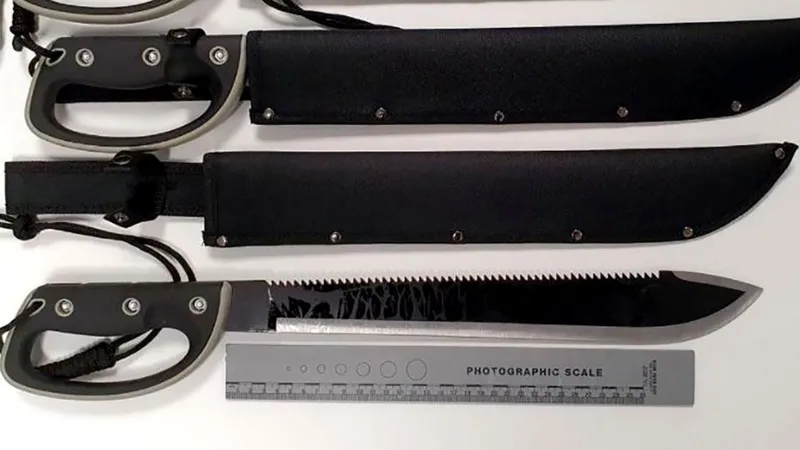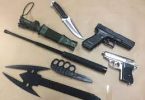Authorities have raised serious concerns after a disturbing number of dangerous weapons—including knives, hammers, and machetes—were confiscated from school premises across multiple regions.
The shocking discovery has sparked urgent calls for enhanced security measures and greater vigilance within educational institutions.
These incidents highlight the growing challenges schools face in ensuring the safety of students and staff in an increasingly volatile environment. Educators, parents, and law enforcement are now working together to address the root causes of weapon possession among students and to prevent future incidents.
With the safety of young people at stake, communities are demanding swift action and comprehensive strategies to keep schools secure and violence-free. The recent seizures serve as a wake-up call that can’t be ignored.
Read More: Dangerous Weapons Confiscated from Schools: Knives, Hammers, and Machetes Found
Dangerous Weapons Confiscated from Schools: A Growing Concern in Greater Manchester
Over 90 Weapons Seized from School Premises
In a troubling revelation, police in Greater Manchester have confiscated more than 90 weapons from schools over the course of the last academic year. The haul included a disturbing range of items—knives, knuckle dusters, hammers, a machete, a saw, and even a metal pole—raising serious questions about student safety and the evolving threats within educational institutions.
Between September 2023 and July 2024, officers responded to 99 separate weapon-related incidents in schools, highlighting the alarming frequency of these events.These figures, made public following a Freedom of Information (FOI) request by the Local Democracy Reporting Service, have sparked widespread concern among educators, parents, and the wider public.
They offer a rare but crucial glimpse into the hidden realities facing many schools, particularly in urban regions where students often feel pressured by the dangers of street life. The volume and variety of weapons confiscated indicate a pattern of fear-driven behavior, rather than malicious intent in many cases.
Knives and Fear: A Deadly Combination
According to the report, 39 of the seized items were knives, making them the most commonly confiscated weapon. This statistic mirrors national trends, where knife-related incidents among youth have steadily risen over the past decade.
However, experts caution against painting all students with the same brush. For many, carrying a knife is less about aggression and more about a sense of protection.
Students Carry Weapons Out of Fear
One Manchester teacher, who requested anonymity due to safety concerns, offered valuable insight into why some students bring weapons to school. She explained that many pupils feel unsafe walking through their neighborhoods, where knife possession has become alarmingly normalized.
“I had the opportunity to ask a pupil why they had brought a weapon to school,” she recalled. “They told me they had no intention of using it, but other people on the streets had them. This was otherwise a good kid.”This anecdote is not unique.
Many young people find themselves trapped between fear and peer pressure, and their decision to carry a weapon is often rooted in a desire to feel protected, not to commit violence.
The Role of Educators and School Staff
Teachers are increasingly expected to act not only as educators but also as first responders to behavioral crises. The presence of weapons in classrooms or school bags puts staff in a precarious position, making them responsible for detecting and preventing potential threats.
Patrick Roach, General Secretary of the NASUWT teachers’ union, commented on the growing crisis:“These shocking statistics underline the support schools need to deal with a weapon-carrying culture.”
He emphasized that schools alone cannot combat this issue. Without coordinated efforts between law enforcement, community leaders, and mental health professionals, the risk of violence will continue to hover over schools.
The Impact on School Safety Culture
The regular appearance of weapons in schools not only endangers students and staff but also erodes the foundational sense of safety and trust in the learning environment.
Parents send their children to school expecting them to be safe, yet the presence of knives and other dangerous items undermines this trust completely.This rise in weapon-related incidents signals a broader social problem.
It reflects what many describe as a “culture of fear” where young people, often growing up in disadvantaged areas, feel they must arm themselves simply to survive.
Policing and Prevention Measures in Place
In response to the disturbing trends, Greater Manchester Police (GMP) has implemented various schemes aimed at curbing youth knife crime. One such initiative is the Forever Amnesty program, which has seen the installation of 13 anonymous knife bins across the region.
These bins allow individuals to surrender weapons without fear of prosecution, offering a pathway out of danger for those who feel trapped in cycles of violence or intimidation.GMP has also conducted outreach programs in schools and community centers, educating youth about the legal and emotional consequences of carrying weapons.
The police force has been invited to comment further on the recent data, and updates are expected to follow.
A Multi-Faceted Solution Is Needed
Solving the weapon crisis in schools will require more than increased policing. It calls for a holistic strategy that includes education, youth engagement, family support, and mental health resources.
Schools must be equipped not just with surveillance tools and metal detectors, but also with counselors, social workers, and restorative justice programs that address the root causes of youth violence.Moreover, community engagement is key. Parents, mentors, and local leaders must work together to shift the narrative around weapons and protection.
Young people need to see alternatives—safe spaces, career opportunities, and role models who reject violence.
Beyond the Numbers: Real Lives at Risk
While statistics and FOI requests help shape public understanding, it’s crucial to remember the human stories behind the headlines. Every confiscated knife represents a student who, for one reason or another, believed carrying it was necessary.
Whether driven by fear, peer pressure, or misguided notions of strength, these students are not beyond help.Interventions at an early stage—before a student feels compelled to carry a weapon—can change the trajectory of a life. It’s essential to recognize the warning signs and create systems that allow students to express fear or distress without judgment.
No Child Should Feel Unsafe
Patrick Roach’s sentiment rings true for many:
“No young person should feel the need to carry a weapon.”This message must be reinforced not just in schools but in homes and communities as well. Students deserve to feel secure—not only within the school gates but also as they walk home, ride the bus, or visit the local park. That sense of security should be a basic right, not a luxury.
Frequently Asked Questions (FAQs)
What types of weapons have been found in schools?
Police in Greater Manchester have confiscated a wide range of weapons, including knives, hammers, machetes, knuckle dusters, saws, and metal poles. The most common weapon seized was the knife, with 39 incidents involving bladed items.
How many weapon-related incidents were reported in Greater Manchester schools?
Between September 2023 and July 2024, there were 99 reported incidents involving weapons in schools throughout Greater Manchester.
Why are students carrying weapons to school?
Many students reported carrying weapons out of fear for their safety, especially when traveling to and from school. Some say they have no intention of using the weapon but carry it because they feel vulnerable on the streets or fear being targeted.
Are schools doing enough to prevent weapons from being brought in?
While schools have procedures in place, many lack the resources or training to effectively address weapon-carrying culture alone. Teachers’ unions argue that schools need greater support from law enforcement, community services, and mental health professionals.
What is Greater Manchester Police doing to address the issue?
GMP has implemented various initiatives, including the Forever Amnesty program, which provides anonymous knife surrender bins in 13 locations across the region. They also conduct educational outreach and prevention campaigns in schools and communities.
Conclusion
The alarming number of weapons seized from Greater Manchester schools paints a troubling picture of fear, insecurity, and the growing challenges educators and authorities face in keeping young people safe. While it’s clear that most students don’t carry these weapons with harmful intent, the mere presence of blades, hammers, and even machetes in educational settings is a wake-up call that cannot be ignored.





